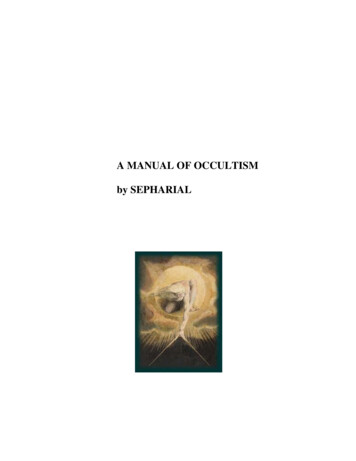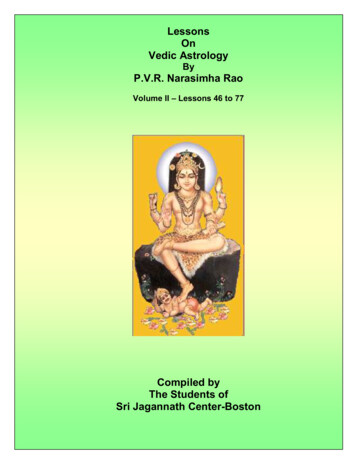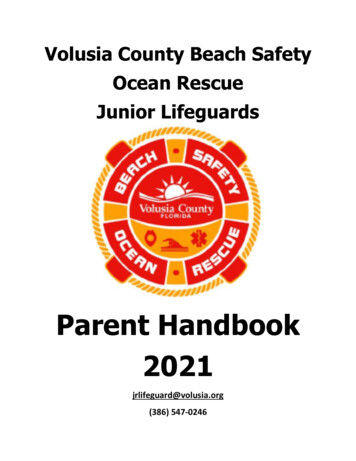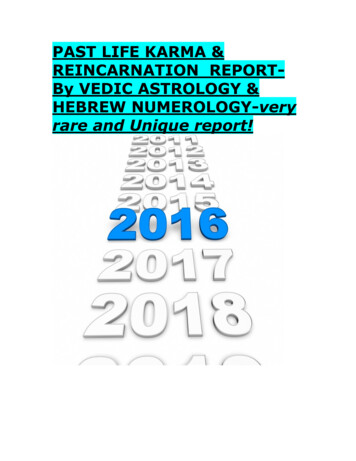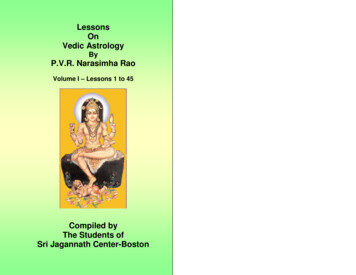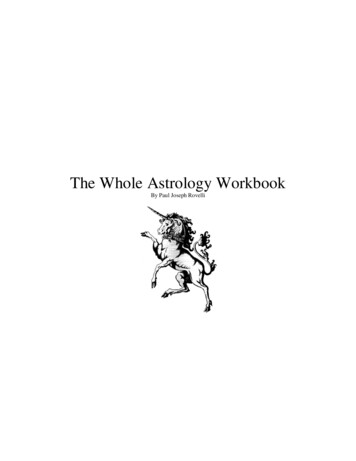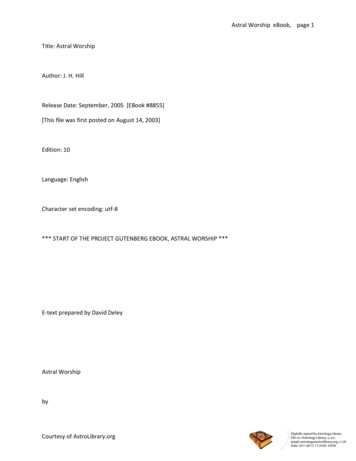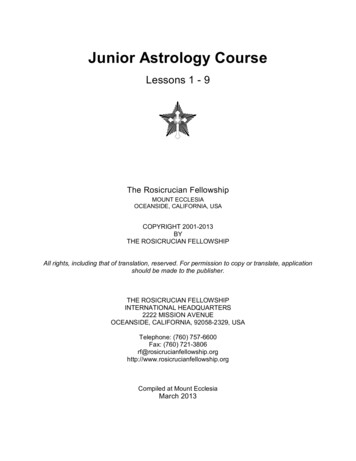
Transcription
Junior Astrology CourseLessons 1 - 9The Rosicrucian FellowshipMOUNT ECCLESIAOCEANSIDE, CALIFORNIA, USACOPYRIGHT 2001-2013BYTHE ROSICRUCIAN FELLOWSHIPAll rights, including that of translation, reserved. For permission to copy or translate, applicationshould be made to the publisher.THE ROSICRUCIAN FELLOWSHIPINTERNATIONAL HEADQUARTERS2222 MISSION AVENUEOCEANSIDE, CALIFORNIA, 92058-2329, USATelephone: (760) 757-6600Fax: (760) icrucianfellowship.orgCompiled at Mount EcclesiaMarch 2013
Table of ContentsIntroduction.3LESSON 1.5LESSON 2.9LESSON 3.13LESSON 4.17LESSON 5.23LESSON 6.26LESSON 7.29LESSON 8.34LESSON 9.38Review and Test to continue lessons.42
Junior Astrology Course, Lessons 1 - 93Dear Friend,We are happy to have your request for our Astrology course. Our three courses in Astrology arebased on the Teachings as given to humanity by the Brothers of the Rosicrucian Order through TheRosicrucian Cosmo-Conception and the personal investigations of Max Heindel, their messenger.In order to realize the most benefit from our Astrology courses we suggest you study ourPreliminary Philosophy Course consisting of twelve lessons. The Preliminary Philosophy Course mustbe completed by regular mail one lesson at a time. We hope that the understanding of life and itsproblems offered by this course will bring you much comfort and joy.A New Age is dawning, and wonderful opportunities await those who understand and cooperatewith the cosmic forces operating to break humanity's bond of materialism and usher in a new orderwith higher spiritual concepts. As we bring ourselves into harmony with these forces, we not onlygreatly hasten our own progress, but make it possible for us to aid in the great work of uplifting allhumanity.These lessons are not sold. The Rosicrucian Teaching is free, but the expenses incidental totheir production and website distribution are met by free-will offerings from students "as the heartdictates and the means permit." However, all receive the same teaching and attention even thoughcircumstances may be such that some are unable to assist in supporting the work.We would love to be able to provide personal one-on-one instruction to all who are interested inour courses, but our resources do not allow this. Therefore, this study course is set up as a collegetype self-study course where the student becomes his own teacher.Please feel that we are your friends, and that we consider it a pleasure and a privilege to assistyou in any way possible to live the higher life, which leads to true happiness and spiritual unfoldment.We send our best wishes for your spiritual progress.Yours in service,The Rosicrucian Fellowship,Education DepartmentMaterials You Can Buy for Our Courses in AstrologyNote: The Information for Astrology Course booklet (AI), available online, contains all of therequired course reference materials found in the books below. With the exception of the required chartcalculation worksheets (HDD or HDP), it contains all of the reference materials needed for the Juniorand Senior Astrology Courses.1] Simplified Scientific Ephemeris for 1911, 1912, and 1932 computed for noon (order Informationfor Astrology Course booklet [AI] or E1911, E1912, and E1932).2] Simplified Scientific Tables of Houses (TBH).3] Simplified Scientific Astrology - Complete textbook on the art of erecting horoscopes, withdictionary of astrological terms (ASP). Available online.4] The Message of the Stars - An esoteric exposition of Natal and Medical Astrology explainingthe arts of reading and progressing the Horoscope and diagnosing diseases (MSP). Available online.5] Horoscope Data Sheets (one pad of 50 - HDP) noon.All of the above can be obtained from our Order Department.
4Junior Astrology Course, Lessons 1 - 9
Junior Astrology Course, Lessons 1 - 95Astrology Letter No. 1Dear Friend,You have before you the first lesson in Spiritual Astrology, but we feel that it would be incompleteif only the mathematical side were elucidated and the spiritual side neglected, for the latter part ofAstrology is the kernel, the essence, while mathematics is only the terms of the outer expression.The hands of the clock show the time of events in daily life, but they would remain inert andmotionless were they not propelled onward by a force in the hidden spring. Their stoppage mightcause us to miss an appointment. The visible planets also mark events of life like the hands of aclock; they also are propelled in their courses by an unseen force analogous to the spring in a clock,except that the Great Spirits whose bodies they are never stop, and therefore we never miss anappointment registered upon the clock of destiny, although we may cancel it — under certaincircumstances — as we do engagements in ordinary life.It is said of Edison that when he was night operator in a railway telegraph office, he put a pailupon a shelf, led a hose from a faucet into it, turned on a small stream of water calculated to fill thepail before the next train was due, placed his chair under the pail, and went to sleep. The overflowingwater compelled him to waken and attend to business as no alarm could have done. We are allturning a constant stream of actions for good or ill into the reservoir of time, and the overflow is alwayscoming back to us and impelling us to new deeds. It does not matter if we have gone to sleep asEdison; even the sleep of death cannot abrogate the deeds of the immortal spirit. A new birth bringseach back exactly when his pail of time is full, so that he may reap what he has sown.It is of the greatest importance that you should understand this viewpoint very thoroughly. We donot have a certain fate because we are born at a certain moment and impelled by stellar rays thenprevailing. If so, we should then have a right to rail at fate for being born under an evil star withoutchoice or prerogative. We should then hate God for making us subject to such a fate. Edison wouldhave had a right to be provoked if any one had awakened him in the manner described, but knowingthat his own act before going to sleep had caused the wetting and realizing the benefit of the heroictreatment, he probably felt well pleased. So with us, if we realize that our own past acts are thedeterminators of our conditions and that the stars simply mark the most favorable time for harvestingwhat we have sown, we shall be more contented and seek to learn the lessons of life instead of railingbecause of what we lack in faculty or fortune.Hoping that you will ponder over these important distinctions and always maintain that we wereborn at a certain time because the positions of the stars were then such as would bring us the fate wehad earned and the lessons to be learned, I am,Yours in Fellowship,Astrology Lesson No. 1In commencing such a course of instruction where the teacher has no means of knowing to whatextent a pupil is informed upon the subject of study, the only safe method is to assume that he knowsabsolutely nothing thereof, otherwise the teacher may omit instruction upon rudimentary matterswhich he thinks are common knowledge, to find later that his neglect has given the pupil wrong ideaswhich may be difficult to eradicate.
6Junior Astrology Course, Lessons 1 - 9Therefore, we shall begin at the beginning of our subject and request students already informedupon matters treated in the early lessons to be patient. The next lessons give instruction in themethod of calculating a horoscope.The Basis of CalculationsTimeA horoscope is simply a chart of the heavens calculated by the rules of astronomy. It showscertain positions of the planets and zodiacal signs in relation to the earth. These positions are notpermanent, however. If they were, the location of the heavenly bodies could be determined once forall time without need of further calculation. The influence of the planets upon the Earth would thenalso remain constant, and there would be no use for astronomy or astrology. But as the Earth makesa complete revolution upon its axis each 24 hours, every point in the northern heavens may be seenonce a day from any point in the northern half of the Earth, and every star in the southern heavensrises and sets each day in every part of the southern half of our globe. The Earth and its sister planetsrevolve around the sun at such varying rates that their positions relative to the Earth and to oneanother are constantly changing. Every day the heavens are different from every other day. If a childwere born now, while you are reading this, the positions of the planets at this moment will not beduplicated for about twenty-six thousand years, a period which the astronomers call a "Great SiderealYear." In the meantime the relations of the planets would undergo an infinite number of kaleidoscopicchanges; consequently their influence would be different with respect to every individual born in theinterval, and thus time becomes a prime factor in the science of astrology.PlaceIt is further evident, however, that time is not the same the world over. When the Sun rises at theplace where you live, it is setting at another place; so that when it is morning in your home, it isevening for the people in another part of the world. This makes another difference in the horoscopesof children born at the same moment but in different parts of the world, as you will readily understandwhen you consider that the Sun's rays affect the Earth differently in the morning, at noon, and atmidnight. The planets' places and influence would also differ in the case of children born at the sametime but in opposite parts of the world, for if a planet were just above the birthplace of one, its rayswould impinge upon that child with unimpeded force, but to reach the other, born in an opposite part, itwould be necessary for the stellar ray to travel directly through the Earth — as radio waves crossmountains — and part of its force would thus be spent by the time it reached the child. Thereforeplanets under the Earth have less influence on a life than those above.Thus you see that time and place are the basic factors in a horoscope, and the more accuratelywe are able to determine them, the better we shall be able to delineate the character and predictevents for those whom we aim to help.The Exact TimeIn noting the time of birth of children it is advisable to have the clock set as accurately aspossible. Mark that the time of birth in the astrological sense is not the moment of delivery but theinstant when the infant gives its first cry, for that cry is the completion of its initial breath. After enteringthe lungs, the air, charged with the subtle stellar influences peculiar to that moment, is carried by theblood through every part of the sensitive little infant body and stamps every atom and memory centerwith its vibrations. This primal impression will prevail during life, though the atoms change again andagain just as a scar perpetuates itself upon the flesh, because the memory center, also called the"seed-atom", located in the heart (see Rosicrucian Cosmo-Conception pages 97-98), retains the firststellar impulse which acts as a blue-print on the Etheric Matrix that controls the various components ofthe atom rebuilt during this lifetime. Therefore, the stellar rays at the moment of birth exert a powerfulinfluence all through life. They are impelling forces which sway us hither and thither as driftwood ispropelled by currents of the sea.
Junior Astrology Course, Lessons 1 - 97It is the purpose of astrology to teach that these forces exist and that by exerting our Will Powerwe may steer the bark of our life as we wish, and bring ourselves to live better lives in harmony withthe Laws of Nature, and also teach how we may help others in like endeavor.The Exact PlaceLatitudeGeographically, the Earth is divided by two sets of imaginary lines, one running from East toWest, and the other from North to South. The circle running East-West halfway between the Northand South poles, as shown in the above chart, is called the Equator. Other circles, called Parallels ofLatitude, are imagined running parallel to the equator, and their use is to measure the distance of anyplace north or south of the equator. Now get an atlas, and look at the map of North America. Alongthe right and left hand borders you will see certain numbers. Note that a curved line runs from number50 on the right to number 50 on the left. This is the fiftieth degree of latitude. All cities along this line,in America, Europe, or Asia are equidistant from the equator, and are said to be located in "Latitude50 North."Another line runs from number 40 on the left border to number 40 on the right. Let us note someof the principal cities on or near this line: San Francisco is a little further south, Denver right on theline; Chicago and New York a trifle north. Now turn to the map of Europe. There the right and lefthand numbers with their connecting circles are also parallels of latitude. At the number 40 you will seeLisbon and Madrid. Proceeding eastward Rome and Constantinople appear a little to the north of ourline.These places may be said, for the purpose of elementary instruction, to be in the same degree oflatitude, and therefore another determinator must be used to differentiate the location of each placefrom all others.LongitudeThis is accomplished by dividing the Earth from pole to pole by another set of imaginary circlescalled Meridians of Longitude, shown in the above chart running the North-South axis. They are so
8Junior Astrology Course, Lessons 1 - 9called because all places located along such a circle have noon at the same instant, regardless ofhow far they are from the equator or whether near the north or south pole.Now look again at your map of Europe. There you will see numbered lines running from the top ofthe map to the bottom. These are meridians of longitude. One is numbered 0. If you follow that lineyou will find London, and close thereto a place called Greenwich. That is the location of the world'sgreatest observatory, and for purposes of astronomical calculation all places on Earth are consideredas being so and so many degrees west or east of Greenwich.Thus, by Latitude we obtain the location of a certain place North or South of the equator. ByLongitude we designate its position East or West of Greenwich.When the location of a place is stated in terms of latitude and longitude, it marks a certain spotbeyond all doubt or possibility of confusion with any other place, and gives the astrologer the secondof the primal factors necessary to calculate a scientific horoscope: place.Questions:1] What is meant by Longitude and Latitude?2] Go to the first section of the Simplified Scientific Tables of Houses or pages 3 and 4 in theInformation For Astrology Course booklet and state the location, i.e., the nearest exact degree (nominutes) of longitude and latitude of:Berlin (Germany)Vienna (Austria)Baghdad (Iraq)Santiago (Chile)Ottawa (Canada)Detroit (Michigan, US)Los Angeles (California, US)Vancouver (Canada)3] When does birth occur from the astrological viewpoint?4] How can the planets at birth influence the whole life?5] What is the purpose of astrology?6] Write the names of the signs of the zodiac and their corresponding symbols.The Source Research Bureau - The Julian and Gregorian CalendarThe true length of the tropical year is not 365.25 days, but 365 days, 5 hours, 48 minutes, and45.5 seconds, leaving a difference of 11 minutes and 14.5 seconds by which the Julian year is toolong. This amounts to a little more than 3 days in 400 years.Pope Gregory, therefore, under the advice of the distinguished astronomer Clavius, ordered thatthe calendar should be corrected by dropping ten days, so that the day following October 4, 1582,should be called the fifteenth instead of the fifth; and further, to prevent any future displacement of theequinox, he decreed that thereafter only such century years should be leap years as are divisible by400.Present differences of the two calendars is thirteen, and will remain so until the year 2100. May12, 1886, according to the Julian calendar would be May 25, 1886, according to the Gregoriancalendar.Source: Manual of Astronomy. Young.
Junior Astrology Course, Lessons 1 - 99Astrology Letter No. 2Dear Friend,Let us consider how the heavens influence our lives through the twelve houses. Suppose we areout driving, and our road follows the seacoast, but a mile or so inland. A breeze is blowing from theocean and as it passes over the country separating us from the sea, it brings upon invisible wings,messages from that land which evoke pleasure or aversion according to their nature. In one place anaroma of new mown hay fills us with delight; perhaps we are nauseated by the oversweet smell ofjasmine on the next stretch of our journey and later become really ill from the stench of stagnantmarsh water. But then we enter a forest, and soon its grateful pine balm restores the normal healthand spirits.In our journey from the cradle to the grave we carry the twelve houses with us in the auricatmosphere surrounding each one of us as the air envelops the flying earth. Each house mirrors partof the life; each holds some of our life lessons; each represents how we have worked or shirkedbefore in that department of life's school. At the appropriate time of life we reap from each house whatwe have sown in past lives—that is, unless we forestall the harvest in time. Is our 11th house afflicted,do friends betray and forsake us, do they leave us heartsick, or nauseate us like the scent of jasmineand stagnant marsh water? Then let us examine the horoscope, for it reveals what is hidden in ourauric atmosphere. The friends saw us and we them through the 11th angle, and something ill-smellingmust be there. It may be that we long to be befriended more than to befriend others. Let us cease tobe like the debilitating jasmine and seek to emulate the sturdy strength of the invigorating pine tree;then we shall find friends flocking around, admiring our strength. Not all have such sturdy natures, butwe can attract equally by kindliness, as soothing to sorrowing hearts as perfume of new mown hay tothe senses, and thus we may rid the house of friends of affliction.Yours in Fellowship,Max HeindelAstrology Lesson No. 2If you go on your housetop or any other convenient elevation on a clear night, you will see a greatmany stars adorning the vaulted arch of heaven, and if you look more closely you will observe thatthey all twinkle--that is to say, with the exception of perhaps one or two which shine with a perfectlysteady light. The twinklers are suns of other solar systems so far away that a traveler going with thespeed of light would require hundreds of years to reach some of them. They move in such enormouscircles and are at such a distance that they appear to maintain the same positions relative to oneanother. Therefore they are called "fixed stars."There is a radical difference between the twinklers and the stars which emit a steady light. If youwatch one of the latter night after night, you will find that it changes position relative to the fixed starsin a direction from west to east, the same as the Sun. Continued observation of the various heavenlybodies whose light is steady will show that they all follow the same path among the maze of fixedstars. Four such luminous planets are visible to the naked eye at various times of the year. Theirnames are Saturn, Jupiter, Mars and Venus. A fifth, Mercury, is usually so close to the Sun that it isinvisible on account of the luminosity of the Sun's rays, but at times it may be seen in the west shortlyafter sunset or in the east just before sunrise. It twinkles like a fixed star, although it is a planet. Thereis a spiritual reason for the anomaly, but as that feature would divert our attention, we will pass it by atpresent.A telescope is required to properly observe the three planets nearest the outskirts of our solarsystem, Uranus, Neptune and Pluto.These eight heavenly bodies move around the Sun. So does the Earth; and the Moon revolvesabout the Earth; but when we look into space it appears as if the Earth stands still, and Sun, Moon,
10Junior Astrology Course, Lessons 1 - 9and planets all move around us. The ancient Ptolemaic system of astronomy in vogue until moderntimes was based upon this conception of the universe, and subscribed to by all until superseded bythe Copernican theory. Skeptics and scoffers who have never taken time nor trouble to investigate,arrogantly maintain that since the Copernican theory has proved that the planets, including the Earth,move around the Sun, that fact in itself is prima facie evidence of the fallacy of astrology, which theyterm as "exploded superstition."We do not care to "convince a man against his will," and deem a defense of astrologysuperfluous, but feel that it may benefit beginners to know the astrologer’s views.When the Sun's rays slant, as they do morning and evening, they give less heat than at noonwhen they are more nearly perpendicular. Although we are millions of miles nearer the Sun inmidwinter than in summer, it is coldest in winter because the Sun's rays are more nearly horizontalthen than at any other time of the year. In summer the scorching heat of the perpendicular ray is notlessened because we are then farthest from the Sun. Thus it is evident from observation that theangle of the ray is practically sole determinator of its effect upon the Earth.Astrology deals also with planetary angles and their observed effects upon humanity. It teachesthat varying angles of Sun and planets give different physical, moral, and mental tendencies. Thediscovery of Copernicus does not render the tabulated statistics of astrologers null and void any morethan it eliminates heat from the solar ray. When a certain angle has been established, acorresponding heat is felt today as before the days of Copernicus, and the finer influences dealt withby astrology are not missing, either.Neither is it an argument against the truth and utility of astrology that predictions sometimes fail. Ifall came true, it would prove life an unprofitable struggle against inexorable fate and the human will ofno avail.Signs and HousesThe path pursued by Sun and planets among the fixed stars, year after year, is called the ecliptic,and the fixed stars grouped near this great circle are called the natural zodiac.In each of the twelve months the Sun appears to travel through a certain group of the zodiacalstars, and therefore they have been divided into twelve natural "signs" of the zodiac. Astrologers alsospeak of twelve "houses," and it is often a sore puzzle to the beginner to differentiate between these"signs" and "houses," and to understand their relation to one another in the horoscope. We shalltherefore try to elucidate the matter as plainly as possible. Procure an orange, apple, or any othersoft, ball-shaped article, and six long knitting needles. Pierce the ball with them in such a manner thatthey resemble twelve spokes in a wheel. The ball will then represent the Earth, and the projectingparts of the needles are dividing lines between house and house, each house being located betweentwo needles.
Junior Astrology Course, Lessons 1 - 911August 2, 1909 at 8:15 PM, Longitude 88 West, Latitude 42 NorthNow, mark this definition, and you will have no difficulty. The twelve signs are divisions of theheavens relative to the Vernal Equinox and the Ecliptic. The twelve houses are divisions of theheavens relative to the birthplace and the horizon.The purpose of the division into signs and houses is to determine the angle of the stellar ray, forupon that depends its influence. In order that you may still better understand the principle, drive one ofthe needles of your wheel into a block of wood so that it stands upright; place it in front of you, andcompare it with the illustration in this lesson which is marked "The Houses." (Diagram No. 1).The small circles in the diagram correspond to your ball or orange, which represents the Earthmoving in space without visible support, and receiving the rays from all the stars and planetsscattered over the vault of heaven.Let us suppose you are standing on top of the Earth ball, or at the point indicated by the arrow inDiagram No. 1. As you are living in the northern part of the world, you look south when you gaze atthe noonday Sun, which is then in its highest elevation, and its ray falls from the angle marked 10 inthe diagram. It has been observed that planets which are in that "tenth house" at the birth of a childaffect its honor and social standing, and therefore the tenth house is said to "rule" these matters.Planets just rising in the east at birth send their rays through the division marked 1, and have beenshown to affect the form of body and conditions of the parental home; hence the "first" house is heldto determine these affairs, and so on with all the other houses.As you know, the Sun appears to travel once around the heavens in a year of 365 days.Mathematicians have made this the basis of their calculations dividing all circles into 360 parts, as itwould have been inconvenient to divide by an uneven number like 365. The Sun travelsapproximately one degree each day, a degree being 1/360th part of a circle.Each of the twelve signs of the zodiac has exactly 30 degrees and this number of degrees in asign never varies, making a complete circle of 360 degrees. Houses are also a division of the heavens
12Junior Astrology Course, Lessons 1 - 9into twelve parts, but because houses are derived from different reference points than signs they donot always contain 30 zodiacal degrees each. For example, in diagram number 2, the 10th housecontains 21 zodiacal degrees (counting from 18 to 30 of Sagittarius is 12 degrees, from 0 to 9 ofCapricorn is 9 degrees - a total of 21 degrees). The 11th house contains 23 zodiacal degrees (9 to 30degrees of Capricorn is 21 degrees plus 0 to 2 degrees of Aquarius gives a total of 23 degrees). Thedeviation of house length from an even 30 degrees becomes more and more pronounced as onemoves further north or south of the equator.NoticeIn order to understand the next lesson you will require an ephemeris for 1912 (refer to the lessoninformation sources on page 3).Questions:1] What is the difference between the signs and the houses?2] What is the difference between the signs of the zodiac and the planets?3] What is a degree? How many degrees are there in each sign?4] How many signs and how many houses are there?5] What determines the influence of a planet?6] How many degrees are there from Aries 1 to Taurus 15?
Junior Astrology Course, Lessons 1 - 913Astrology Letter No. 3"Who seeks for heaven alone, to save his soul,May keep the law, yet will not reach the goal.Who walks in love may sometimes wander far;Yet God will bring him where the blessed are."These are lines by an unknown poet, but they ring absolutely true to the teachings of Christ inregard to the rich young man, and also to the teachings given in Paul's inimitable 13th chapter of 1stCorinthians. Love is the source of life; love alone makes life worth living, and therefore I feel that in acourse of astrology from the Mystic's viewpoint the planet of love, Venus, has first claim on ourconsideration.You know that each house represents a certain department of life, and when you learn theintrinsic value of the planets you will be able to read a message from the stars independently of booksand authorities. By exercising your own divine power of reason to combine the simple basic factors,you may become an astrologer (the name means reasoner concerning the stars); any brainless pollparrot can babble about what the books say. It is easy to read and recite; but it requires thought toreach an independent conclusion and give an adequate interpretation of the stellar script. That effort,however, is productive of wonderful soul growth, so I hope that you will read little but think much; thenyou will develop a deeper and more reliable knowledge than the most erudite authorities can impartand a soul-power of inestimable value, namely, intuition.I can teach you how to erect a horoscope; there are certain definite, hard and fast rules; butneither I nor anyone else can teach you how to read in an adequate manner. The best method is toaid students to combine the basic factors of horoscopical judgment and to draw logical conclusionstherefrom. This we will commence in our next letter.Yours in Fellowship,Max HeindelAstrology Lesson No. 3True Local TimeIn our first lesson we spoke about time in general. We will now consider a special kind of time,namely, True Local Time. This is the same as Sun Time, which is gauged by the instant when the Suncrosses the meridian (when it is directly overhead) at any particular place. This instant marks TrueLocal Noon for that place. We will also learn how to convert Standard Time, the prevailing time in theUnited States, into True Local Time.Prior to November 18, 1883, the time used in any particular locality was Sun Time, that is, TrueLocal Time.But since that time it has been found convenient to substitute what is called Standard Time, forSun Time, particularly in America, and therefore the student shoul
Junior Astrology Course, Lessons 1 - 9 3 Dear Friend, We are happy to have your request for our Astrology course. Our three courses in Astrology are based on the Teachings as given to humanity by the Brothers of the Rosicrucian Order throughThe Rosicrucian Cosmo-Conception and the



